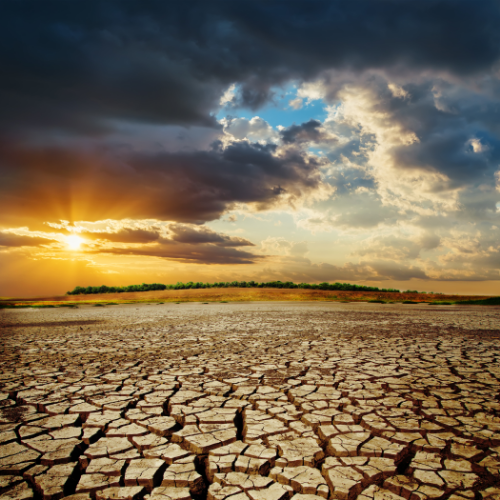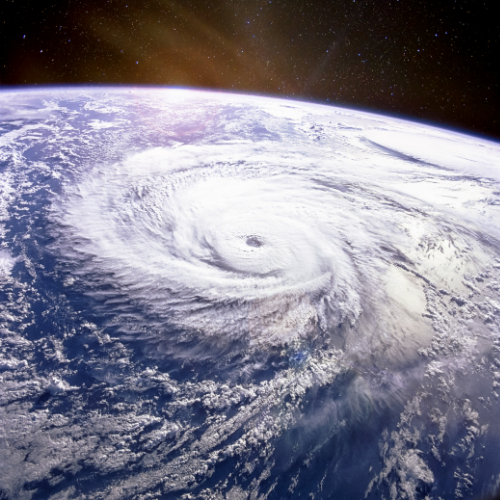WHAT IS CLIMATE CHANGE?
Before we look at climate change, it’s important to first understand the difference between weather and climate. Weather is the current condition the atmosphere is in, at any given time eg. it is raining today, but sunny tomorrow. Climate is the long-term trend or pattern in the weather conditions in an area, studied over a long time period eg. A tropical equatorial area will have warm temperatures all year, high humidity and high rainfall.
Read More
What are the factors that contribute to determining an area’s climate?
- Latitude – how far north or south of the equator the location is
- Altitude – how high above sea level the area is (this affects pressure, and therefore how much moisture and heat the air can hold)
- Distance from sea – areas of land are affected by oceanic currents (warm or cold currents)
What is climate change?
Climate change is a shift in an area’s long-term climatic conditions. However, in order to understand what climate change is, it’s important to understand what the natural greenhouse effect is first, as the enhancement or acceleration of this process is what is contributing to the climate change we are observing now.
What is the greenhouse effect?
The greenhouse effect is a natural phenomenon that has been occurring on the Earth for millennia. It is a natural process that ensures that our Earth has the perfect ‘liveable’ conditions to sustain life. The greenhouse effect occurs as gases in the Earth’s atmosphere trap heat within the atmosphere that is radiating out from the Earth. This radiation is being bounced off the Earth from the incoming rays from the sun.
These gases include:
- Carbon dioxide (CO2)
- Water vapour (H2O)
- Methane (CH4)
- Ozone (O3)
The gases act like a blanket, making the Earth, on average, about 15 degrees Celsius warmer that it would otherwise be. Much colder average temperatures would mean life could not survive on our planet.
Water vapour is the most powerful greenhouse gas (because it can absorb the most heat), however it does not remain longer than a few days in the atmosphere. Methane, if not burnt, is more potent than carbon dioxide in terms of its ability to hold heat. It can persist in the atmosphere for about a decade. However, the most dangerous greenhouse gas in the long term is carbon dioxide. This is because it can endure in the atmosphere for much longer than water vapour or methane. Carbon dioxide can remain for thousands to hundreds of thousands of years.
What does human-induced climate change mean?
Humans have been around on the Earth for some thousands of years. However, it is only in the last 200 years or so that we have been producing extremely high quantities of greenhouse gases through our development and industrialisation activities. These gases (mostly carbon dioxide) are associated with the wastes from combustion (burning) of fossil fuels, most of which is associated with industrialisation.
Is there evidence of climate change happening in the past?
Scientists have drilled into the deep ice of polar regions to find out how much carbon there has been in the atmosphere in Earth’s history. These carbon molecules are dated using radioactive carbon dating (which is based on the rate of decay of the radioactive parts of carbon). There is evidence that the Earth’s climate has been fluctuating from warm to cold over the past several hundred thousand years. This means that climate change has been happening naturally since the Earth became habitable. The carbon dating shows that the climate has shifted in roughly 10 000-year cycles, with some cycles being colder and some being warmer. This can be associated with lower and higher concentrations of carbon dioxide in the atmosphere respectively.
Is human-induced climate change happening now?
The current evidence for climate change is that the rate of the warming (in the already warm cycle that we have been in for a few thousand years) is much faster than the rate it would have been in one of the 10 000-year cycles. One of the assumptions of this is that this time coincides with the time we have had our greatest population and industrialisation activities. We have put more greenhouse gases into the atmosphere than natural cycles (such as the carbon cycle) can cope with.
Predicted impacts of climate change
In general, most scientists agree on a few main trends with what we will see with changing climates around the world:
- Some places will be drier or have longer dry seasons and more frequent droughts
- Some areas will be wetter, with longer wet seasons
- The strength of tropical storms (hurricanes) will increase
- The length of growing seasons for some crops will be longer (so more crops can be harvested)
- Other regions there will have reduced crop harvests due to drier conditions (especially South and Central America, Sub-Saharan Africa and South East Asia)
- Sea levels will rise (mostly due to thermal expansion of water in the oceans, but also due to the melting of ice that’s on land)
- Animals (fauna) will migrate to the areas that have the conditions and vegetation that they require, expand or shift their territories or become extinct.
- Although plants cannot move, they can slowly, over time, spread or shift their coverage to a more suitable location or become extinct.
Of course, these impacts can be viewed to be both positive and negative, depending on where you live and what your needs are (or what species you are!). Nevertheless, the impacts will be felt by us all. Plants and animals are relatively adaptable and can cope with new conditions through evolution. The problem is that their time scales for evolving are much slower (eg. Over thousands of years) than the current rate of climate change (changing in just over just 50 years). In addition, generally it will be the most vulnerable parts of our human society that feel and will continue to feel the negative impacts of climate change the most.
Read Less




What Is Climate Change?




Before we look at climate change, it’s important to first understand the difference between weather and climate. Weather is the current condition the atmosphere is in, at any given time eg. it is raining today, but sunny tomorrow. Climate is the long-term trend or pattern in the weather conditions in an area, studied over a long time period eg. A tropical equatorial area will have warm temperatures all year, high humidity and high rainfall.
Read More
What are the factors that contribute to determining an area’s climate?
- Latitude – how far north or south of the equator the location is
- Altitude – how high above sea level the area is (this affects pressure, and therefore how much moisture and heat the air can hold)
- Distance from sea – areas of land are affected by oceanic currents (warm or cold currents)
What is climate change?
Climate change is a shift in an area’s long-term climatic conditions. However, in order to understand what climate change is, it’s important to understand what the natural greenhouse effect is first, as the enhancement or acceleration of this process is what is contributing to the climate change we are observing now.
What is the greenhouse effect?
The greenhouse effect is a natural phenomenon that has been occurring on the Earth for millennia. It is a natural process that ensures that our Earth has the perfect ‘liveable’ conditions to sustain life. The greenhouse effect occurs as gases in the Earth’s atmosphere trap heat within the atmosphere that is radiating out from the Earth. This radiation is being bounced off the Earth from the incoming rays from the sun.
These gases include:
- Carbon dioxide (CO2)
- Water vapour (H2O)
- Methane (CH4)
- Ozone (O3)
The gases act like a blanket, making the Earth, on average, about 15 degrees Celsius warmer that it would otherwise be. Much colder average temperatures would mean life could not survive on our planet.
Water vapour is the most powerful greenhouse gas (because it can absorb the most heat), however it does not remain longer than a few days in the atmosphere. Methane, if not burnt, is more potent than carbon dioxide in terms of its ability to hold heat. It can persist in the atmosphere for about a decade. However, the most dangerous greenhouse gas in the long term is carbon dioxide. This is because it can endure in the atmosphere for much longer than water vapour or methane. Carbon dioxide can remain for thousands to hundreds of thousands of years.
What does human-induced climate change mean?
Humans have been around on the Earth for some thousands of years. However, it is only in the last 200 years or so that we have been producing extremely high quantities of greenhouse gases through our development and industrialisation activities. These gases (mostly carbon dioxide) are associated with the wastes from combustion (burning) of fossil fuels, most of which is associated with industrialisation.
Is there evidence of climate change happening in the past?
Scientists have drilled into the deep ice of polar regions to find out how much carbon there has been in the atmosphere in Earth’s history. These carbon molecules are dated using radioactive carbon dating (which is based on the rate of decay of the radioactive parts of carbon). There is evidence that the Earth’s climate has been fluctuating from warm to cold over the past several hundred thousand years. This means that climate change has been happening naturally since the Earth became habitable. The carbon dating shows that the climate has shifted in roughly 10 000-year cycles, with some cycles being colder and some being warmer. This can be associated with lower and higher concentrations of carbon dioxide in the atmosphere respectively.
Is human-induced climate change happening now?
The current evidence for climate change is that the rate of the warming (in the already warm cycle that we have been in for a few thousand years) is much faster than the rate it would have been in one of the 10 000-year cycles. One of the assumptions of this is that this time coincides with the time we have had our greatest population and industrialisation activities. We have put more greenhouse gases into the atmosphere than natural cycles (such as the carbon cycle) can cope with.
Predicted impacts of climate change
In general, most scientists agree on a few main trends with what we will see with changing climates around the world:
- Some places will be drier or have longer dry seasons and more frequent droughts
- Some areas will be wetter, with longer wet seasons
- The strength of tropical storms (hurricanes) will increase
- The length of growing seasons for some crops will be longer (so more crops can be harvested)
- Other regions there will have reduced crop harvests due to drier conditions (especially South and Central America, Sub-Saharan Africa and South East Asia)
- Sea levels will rise (mostly due to thermal expansion of water in the oceans, but also due to the melting of ice that’s on land)
- Animals (fauna) will migrate to the areas that have the conditions and vegetation that they require, expand or shift their territories or become extinct.
- Although plants cannot move, they can slowly, over time, spread or shift their coverage to a more suitable location or become extinct.
Of course, these impacts can be viewed to be both positive and negative, depending on where you live and what your needs are (or what species you are!). Nevertheless, the impacts will be felt by us all. Plants and animals are relatively adaptable and can cope with new conditions through evolution. The problem is that their time scales for evolving are much slower (eg. Over thousands of years) than the current rate of climate change (changing in just over just 50 years). In addition, generally it will be the most vulnerable parts of our human society that feel and will continue to feel the negative impacts of climate change the most.
Read Less

Carbon Offset Advisory acknowledges the traditional owners and custodians of country throughout Australia and acknowledges their continuing connection to land, water and community.
We pay our respects to the people, the cultures and the elders past, present and emerging.

